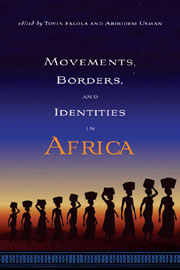Book contents
- Frontmatter
- contents
- Preface
- Introduction: Migrations in African History: An Introduction
- PART A State Formation and Migration Crossroads
- 1 Frontier Migrations and Cultural Transformations in the Yoruba Hinterland, ca. 1575–1700 The Case of Upper Osun
- 2 The Root Is Also Here: The Nondiaspora Foundations of Yoruba Ethnicity
- 3 Settlement Strategies, Ceramic Use, and Factors of Change among the People of Northeast Osun State, Nigeria
- 4 Precolonial Regional Migration and Settlement Abandonment in Yorubaland, Nigeria
- 5 Migrations, Identities, and Transculturation in the Coastal Cities of Yorubaland in the Second Half of the Second Millennium: An Approach to African History through Architecture
- PART B Movements and Identities
- List of Contributors
- Index
5 - Migrations, Identities, and Transculturation in the Coastal Cities of Yorubaland in the Second Half of the Second Millennium: An Approach to African History through Architecture
from PART A - State Formation and Migration Crossroads
Published online by Cambridge University Press: 12 September 2012
- Frontmatter
- contents
- Preface
- Introduction: Migrations in African History: An Introduction
- PART A State Formation and Migration Crossroads
- 1 Frontier Migrations and Cultural Transformations in the Yoruba Hinterland, ca. 1575–1700 The Case of Upper Osun
- 2 The Root Is Also Here: The Nondiaspora Foundations of Yoruba Ethnicity
- 3 Settlement Strategies, Ceramic Use, and Factors of Change among the People of Northeast Osun State, Nigeria
- 4 Precolonial Regional Migration and Settlement Abandonment in Yorubaland, Nigeria
- 5 Migrations, Identities, and Transculturation in the Coastal Cities of Yorubaland in the Second Half of the Second Millennium: An Approach to African History through Architecture
- PART B Movements and Identities
- List of Contributors
- Index
Summary
Introduction
Studies of African architecture are rare, and many lacunae remain in the few works in this area. The architecture of African historical centers is in peril, and historical buildings are being destroyed as a result of economic activities, development projects, and land speculation. For example, the majority of the finest historical buildings on Lagos Island have been demolished and replaced by modern towers that reflect the current dynamism of the city.
Built during the nineteenth and twentieth centuries, these historical structures, called Afro-Brazilian buildings, are generally associated with colonial architecture. However, on closer examination, the word “colonial” appears justified only in reference to the features of colonial Brazilian architecture that distinguished the buildings. This architecture owes its features to freed slaves returning from the Americas. These ex-slaves, most of whom resettled in the societies from which they had departed, especially in the coastal region of West Africa, introduced new ways of life and new architectural styles acquired from the lands of their sojourn overseas. By examining patterns of international and interregional migration and of settlement, it is possible to detect and understand the cultural mix that contributed to and enriched Yoruba culture in the coastal region, especially in terms of architecture.
Using concrete examples, genealogical inquiries, narratives of travelers, and historical essays, this chapter1 demonstrates the way in which the architectural features of the Afro-Brazilian buildings bear out the dynamism found in the population and encode its economic and cultural transformation.
- Type
- Chapter
- Information
- Movements, Borders, and Identities in Africa , pp. 126 - 150Publisher: Boydell & BrewerPrint publication year: 2009



